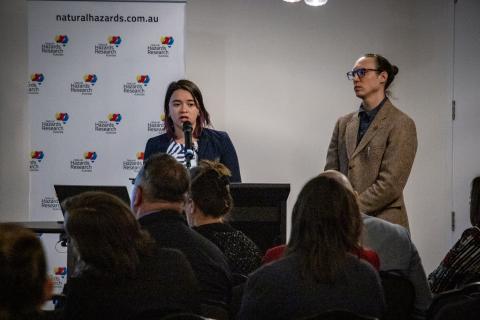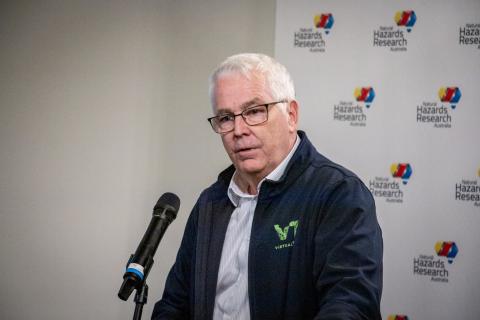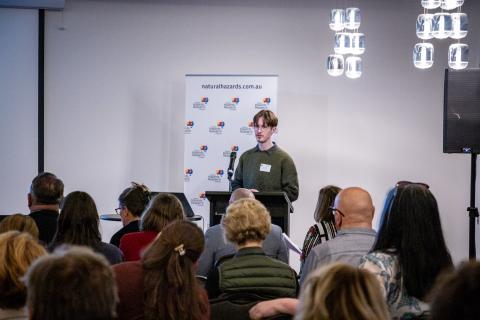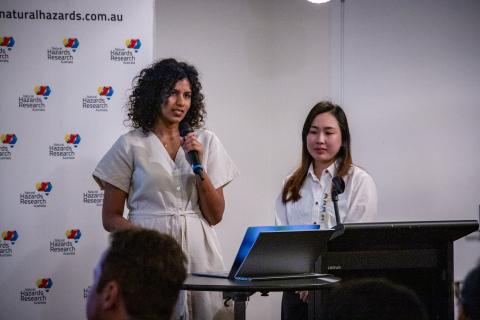


A passionate local Tasmanian team focused on empowering coastal communities has taken out the top prize at this year’s Natural Hazards Research Australia Disaster Challenge Final, held in Hobart this week.
The winning team, Thriving coastal futures in southern Tasmania, impressed judges with their innovative, community-driven approach to protecting Australia’s coastlines from the growing impacts of sea level rise and extreme weather.
This solution integrates blue-green infrastructure, citizen science and trauma-informed community engagement to strengthen coastal resilience and restore ecosystems, all while ensuring local voices remain at the heart of decision making.
Team members Dr Malcolm S Johnson (Huon Valley Council), Bianca Suarez (Australian National University), Edith Shum (University of Tasmania), Kianna Gallagher (University of Tasmania), Hevi Kurnia Hardini (Australian Maritime College), and Rosie Katunar (Department of Natural Resources and Environment Tasmania), are all also affiliated with the Centre for Marine Socioecology.

Photo: Bianca Suarez and Dr Malcolm Johnson
The team were inspired by the people and places that motivated their research, particularly the Garden Island community.
“Without the inspiration our community provides, we wouldn’t be up here. The only way we solve these massive, wicked problems is by working with communities that care and are truly passionate," Dr Malcom Johnson said.
The 2025 Disaster Challenge brought together some of the nation’s emerging leaders to pitch bold, research-driven ideas that could transform Australia’s approach to natural hazards and disaster resilience.
The Hon Kristy McBain MP, Minister for Emergency Management, Minister for Regional Development, Local Government and the Territories provided a special video message, emphasising the importance of supporting innovative ideas and diverse perspectives in addressing the increasing frequency and complexity of disasters.
Natural Hazards Research Australia CEO Andrew Gissing welcomed more than 100 attendees and encouraged teams to continue thinking boldly.
“We have been talking about the cascading and compounding impacts of disasters on communities,” he said. “To stay ahead of ready, we need big, bold ideas and the science and innovation to bring them to life.”
Keynote speaker Ian McLeod, Director of Smart Energy and Water, Enzen Australia and CEO, Virtual TAS, reinforced this message, sharing how research and technology are transforming disaster resilience across Australia. Ian highlighted how innovations such as digital twin technology and LiDAR data capture are improving bushfire preparedness, infrastructure protection and community safety. His keynote underscored the critical role of science and strong collaboration in reducing the economic and social impacts of disasters.

Photo: Ian Mcleod
The Disaster Challenge is held annually to mark the United Nations International Day for Disaster Risk Reduction, celebrating innovation, collaboration and science that advance Australia’s resilience to natural hazards.
This year’s finalists demonstrated the power of research, creativity and community partnership in shaping the future of disaster resilience, showing that with bold thinking, we can truly Be Ahead of Ready.
Recognising innovation: outstanding runners-up
Two teams were also recognised for their outstanding research-driven innovations.
First runner-up: A digital twin for real-time flood insights, Ryan Turner (RMIT University), for his data-driven flood management solution, using digital twin technology to provide near real-time flood insights, future flood prediction and historical data visualisation. The platform aims to support decision makers, emergency services and communities with accessible, on-demand analytics for better flood preparedness and response.

Photo: Ryan Turner
Second runner-up: From verge to vital: People-powered green spaces for climate and disaster resilience, made up of Evelyn Liew, Anjalee Panditha and Sebastian Bernal Garcia (Griffith University) were recognised for their creative vision to rewild Australian suburbs by transforming urban verges and underutilised concrete zones into low-maintenance, nature-based bioretention areas. Combining digital monitoring with community collaboration, their approach helps manage stormwater, strengthen biodiversity and build climate-resilient cities.

Photo: Anjalee Panditha and Evelyn Liew
Natural Hazards Research Australia extends its thanks to the 2025 Disaster Challenge expert judging panel for their time, expertise and insight:
We also acknowledge the invaluable contribution and mentorship provided by the 2025 Disaster Challenge Working Group Members:
Their support and guidance were instrumental in shaping the challenge and fostering the next generation of disaster resilience innovators.